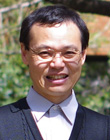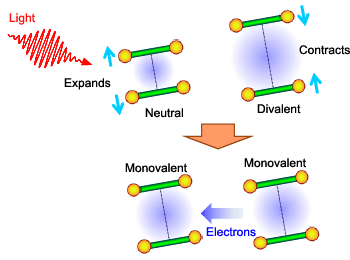Top>Opinion>The Mechanism that Changes Properties in a Flash of Light
 Index
Index

Kenji Yonemitsu [profile]
The Mechanism that Changes Properties in a Flash of Light
Kenji Yonemitsu
Professor, Faculty of Science and Engineering, Chuo University
Areas of Specialization: Condensed Matter Theory, Molecular Substances, Photoinduced Phase Transitions
1. Introduction
There are many substances all around us, each with different characteristics, which are used in our daily lives. What’s more, there are cases where changes in the characteristics of substances (properties) are useful. Condensed matter physics studies how properties manifest and change — e.g., how substances appear (reflecting vs. absorbing light), whether electricity passes easily through them (conductivity), and what happens to them when they are brought close to a magnet (magnetism). Recently, interest has been focused on the question of whether such properties can be changed instantaneously. Properties can be changed in a moment; for instance, by beaming light on an insulator for only about 10-14 seconds, it becomes a metal within 10-12 seconds.
2. Myriad electrons and properties
The various characteristics of substances are determined by electrons. Electrons move in the micro-world in accordance with quantum mechanics. In my research lab, we conduct theoretical research on what state various electrons are in and how they change when light is beamed on them. In the world of quantum mechanics, it is not possible to determine exactly where things are, as with classical particles, nor is it possible to determine exactly how fast they are transmitted, as with waves. However, to put it in rough terms, materials become an insulator when their electrons avoid each other and are regularly aligned or become a metal when their electrons are spreading like a wave. In order to turn an insulator into a metal by beaming light on it, it is necessary to change the behavior of many electrons from the former to the latter all at once.
3. Molecular substances
Among the many kinds of substances, those created by the accumulation of molecules are studied in detail as they demonstrate various types of conductivity and magnetism. Molecular substances are layered, in the following manner: atoms combine to become a molecule; two molecules, for instance, combine to become a molecular pair; these arrange themselves in two dimensions to become a layer; and these accumulate to become a crystal. The substance Et2Me2Sb[Pd(dmit)2]2 studied by us, which is shown schematically in Figure 1, is a substance in which pairs of Pd(dmit)2 molecules are aligned two dimensionally and electrons move within the plane. Et2Me2Sb is deprived of one electron and the molecular pair receives one excess electron, becoming monovalent. However, at low temperatures, the neutral molecular pair and divalent molecular pair with two excess electrons line up regularly. This is called a charge-ordered insulator.

Figure 1. (a) Model of Pd(dmit)2 molecule (b) [Pd(dmit)2]2 molecular pair (c) Melting the charge order with light
4. Electron distribution and molecular arrangement
Why do neutral molecular pairs and divalent molecular pairs line up regularly with this substance, as shown in Figure 1? The reason is that the intermolecular distance of the molecular pairs changes in accordance with the electron distribution. As shown in Figure 2, the intermolecular distance becomes shorter for the neutral molecular pairs and longer for the divalent molecular pairs. In this way, the charge order is stabilized. This means that if the molecular pairs are destabilized slightly by beaming light on them, the intermolecular distance will change.

Figure 2: Motion of Electrons and Vibration of Lattice after Exposure to Light
5. Beaming light for only an instant
Light is a type of electromagnetic wave, and its electrical and magnetic fields vibrate. Since the electrical field vibrates, electrons are shaken. The time scale of this is determined by the light vibration frequency. The time scale of electron movement within a substance is determined by the overlapping of molecular orbitals — to put it in rough terms, when molecules are close together, that makes it possible for them to move rapidly back and forth. Another important time scale is molecular vibration. Since the electron distribution changes when the electrons move back and forth, the molecular shape and intermolecular distance also change slightly. The vibration that occurs due to this (lattice vibration) is slower than the movement of the electrons. The timing of these is important.
6. Concerted movement
Let us look at how the respective movements are related (Figure 2). In previously published experiments, the vibration frequency of beamed light is aligned with the timing of electron movement in neutral molecular pairs. Thus, neutral molecular pairs beamed with light are destabilized slightly and the intermolecular distance becomes slightly longer. As a result, a few electrons move from divalent molecular pairs toward neutral molecular pairs. Due to this, the intermolecular distance becomes shorter for divalent molecular pairs. When the intermolecular distance of neutral molecular pairs and divalent molecular pairs becomes roughly equivalent in this way, it becomes easier for electrons to move back and forth between these molecular pairs. As a result, since electrons are set in motion all at once, electrons which have been arrayed in a regular manner spread uniformly. The movement of electrons between and within molecules and the vibration of the lattice are concerted, and a dramatic change occurs.
7. Conclusion
When it comes to turning the substance Et2Me2Sb[Pd(dmit)2]2 addressed here into an insulator at low temperatures, the relationship between the number of electrons in the molecular pairs and the intermolecular distance is important. In general, to change a property by beaming light on it, it is necessary to understand how the movement of electrons between and within molecules and the vibration between and within molecules are intertwined. If we continue to move forward with theoretical research on the various movements caused by light, combined with experimental research, it may be possible to purposefully control substances and develop new applications of them. If the agents that govern properties — i.e., the timing of electron movements and lattice vibrations — can be used properly, it will be possible to successively link their movements, eventually leading to significant changes.
In closing, the author would like to note that the findings of this research were obtained in collaboration with Dr. Keita Nishioka.
References
- Kenji Yonemitsu, Solid State Physics [Kotai Butsuri] Vol. 48, No.1, p.p. 1-12, (2013).
- K. Nishioka and K. Yonemitsu, J. Phys. Soc. Jpn. 82, 024701 (2013).
- K. Nishioka and K. Yonemitsu, J. Phys. Soc. Jpn. 82, 094716 (2013). (Paper of Editors’ Choice)
- Yonemitsu Group website

- Kenji Yonemitsu
Professor, Faculty of Science and Engineering, Chuo University
Areas of Specialization: Condensed Matter Theory, Molecular Substances, Photoinduced Phase Transitions - Born in Miyazaki Prefecture in 1963, Professor Yonemitsu graduated from the Department of Physics, Faculty of Science, the University of Tokyo in 1985. In 1987, he completed his master’s degree in physics at the Graduate School of Science, the University of Tokyo, and in 1990, completed his Ph.D. in physics at the same institution (Doctorate of Science). He assumed his present position (Professor, Faculty of Science and Engineering, Chuo University) in 2012 after being a postdoctoral research fellow at Los Alamos National Laboratory (U.S.), the International Centre for Theoretical Physics (Italy), and the University of Georgia (U.S), an assistant professor at the Graduate School of Information Sciences of Tohoku University, an associate professor of Department of Applied Physics at the Faculty of Engineering of Tohoku University, and an associate professor at the Institute for Molecular Science of the National Institutes of Natural Sciences and the School of Mathematical and Physical Science of the Graduate University for Advanced Studies. His current research subjects are theoretical research on the properties of correlated electron systems in non-equilibrium environments and photoinduced phase transition dynamics.
- Research Activities as a Member of Research Fellowship for Young Scientists (DC1), Japan Society for the Promotion of Science (JSPS) Shuma Tsurumi
- Important Factors for Innovation in Payment Services Nobuhiko Sugiura
- Beyond the Concepts of Fellow Citizens and Foreigners— To Achieve SDGs Goal 10 “Reduce Inequality Within and Among Countries” Rika Lee
- Diary of Struggles in Cambodia Fumie Fukuoka
- How Can We Measure Learning Ability?
—Analysis of a Competency Self-Assessment Questionnaire— Yu Saito / Yoko Neha - The Making of the Movie Kirakira Megane








